Background
Assyria was the world power and Sennacherib, its king, rode high in the saddle. He had conquered and destroyed the cities of the Northern Kingdom including Samaria and relocated the remaining inhabitants to Assyria. This was in 722-721 BC. Hezekiah, king of the Southern Kingdom of Judah feared that Jerusalem would fall to the Assyrians, so he strengthen Jerusalem’s walls, some of this work survives and can be seen today. As well, he had a tunnel cut through 530 metres of rock to bring water from the Gihon spring into the city to ensure that its inhabitants had water in the time of a siege. This tunnel still brings water into Jerusalem, and people can walk and at times, crouch, its entire length through knee-deep water.
King Sennacherib had destroyed all the surrounding cities[1] in the Southern Kingdom, Lachish was the last to fall and Sennacherib had drawings of its capture inscribed in some of the walls of his palace in Nineveh. On approaching Jerusalem, his commander shouted a message to Hezekiah to surrender because he had no hope, the people of the other cities, 46 in all, had prayed to their gods to protect them, but their cities fell anyway, so what makes you think that your God can save you?[2]
The difference was that Hezekiah prayed to the one true God and the next morning, 185,000 Assyrian soldiers lay dead. This remarkable incident was recorded not only in the Bible, its primary reference, but also, by the Greek historian Herodotus, who referred to it in his manuscript, Histories which he wrote in approximately 450 BC. However, Herodotus tried to rationalise what had happened by suggesting that maybe field mice gnawed the quivers, bows and shield handles of Sennacherib’s soldiers, leaving them unarmed for battle the following day.[3]
Scripture tells us of this event Isaiah 37:36-37 and 2 Kings 19:35 which is given here:
And that night the angel of the Lord went out and struck down 185,000 in the camp of the Assyrians. And when people arose early in the morning, behold, these were all dead bodies.
The above has been confirmed by archaeology and I have written about it here: https://www.adefenceofthebible.com/2020/05/29/assyrian-king-confirms-scripture.
But there is more
Scripture then goes on to say: Verse 36 and 37
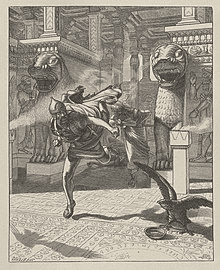 Then Sennacherib king of Assyria departed and went home and lived at Nineveh. And as he was worshiping in the house of Nisroch his god, Adrammelech and Sharezer, his sons, struck him down with the sword and escaped into the land of Ararat. And Esarhaddon his son reigned in his place.
Then Sennacherib king of Assyria departed and went home and lived at Nineveh. And as he was worshiping in the house of Nisroch his god, Adrammelech and Sharezer, his sons, struck him down with the sword and escaped into the land of Ararat. And Esarhaddon his son reigned in his place.
So, after his army was demolished by the angel of the Lord, Sennacherib goes back to Nineveh. Sometime later, we are not told how long, while he was praying to his god, two of his sons killed him. Does archaeology shed any light on this event?
Yes. After the death of his eldest son and crown prince, Ashur-nadin-shumi, Sennacherib originally designated his second son Arda-Mulissu (Adrammelech in Hebrew) his heir. He later replaced him with a younger son, Esarhaddon, in 684 BC, for unknown reasons. Sennacherib ignored Arda-Mulissu’s repeated appeals to be reinstated as heir, and in 681 BC, Arda-Mulissu and his brother Nabu-shar-usur murdered Sennacherib, hoping to seize power for themselves.[4]
The image right is The Flight of Adrammelech, illustration from Dalziel’s Bible Gallery (1881), depicting Arda-Mulissu and Nabu-shar-usur escaping after murdering their father Sennacherib. Credit: Wikipedia commons.
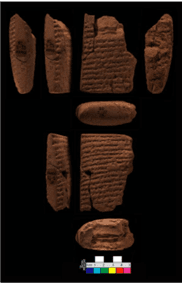 The Assyrian tablets (British Museum 1880,0719.28) were discovered by Hormuzd Rassam in the Southwest palace in the ruins of Nineveh. The broken clay tablets comprise a letter concerning Arda-Mulisha’s conspiracy to murder his father Sennacherib.
The Assyrian tablets (British Museum 1880,0719.28) were discovered by Hormuzd Rassam in the Southwest palace in the ruins of Nineveh. The broken clay tablets comprise a letter concerning Arda-Mulisha’s conspiracy to murder his father Sennacherib.
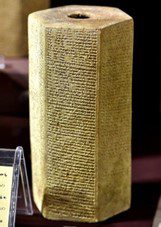 An Assyrian inscription of Esserhaddon (British Museum 121005,CC BY_NC_SA 4.0) alludes to his father’s violent death at the hands of his brothers: I am my older brothers’ youngest brother (and) by the command of the gods Aššur, Sîn, Šamaš, Bēl, and Nabû, Ištar of Nineveh, (and) Ištar of Arbela, (my) father, who engendered me, elevated me firmly in the assembly of my brothers, saying: ‘This is the son who will succeed me.’
An Assyrian inscription of Esserhaddon (British Museum 121005,CC BY_NC_SA 4.0) alludes to his father’s violent death at the hands of his brothers: I am my older brothers’ youngest brother (and) by the command of the gods Aššur, Sîn, Šamaš, Bēl, and Nabû, Ištar of Nineveh, (and) Ištar of Arbela, (my) father, who engendered me, elevated me firmly in the assembly of my brothers, saying: ‘This is the son who will succeed me.’
The inscription goes on to say: ‘Thereafter my brothers went mad and whatever was wicked against gods and men they did and plotted evil: they drew the sword in the midst of Nineveh godlessly: to exercise the kingship against each other they rushed like young steers.’ Essarhadon proceeds to relate how, when he heard the news of his father’s murder, cried, ‘Woe and rent his princely robe. He then chased the “usurpers.’” and records how, ‘those rebels, the ones engaged in revolt and rebellion, when they heard of the advance of my campaign, they deserted the army they relied on and fled to an unknown land.’[5]
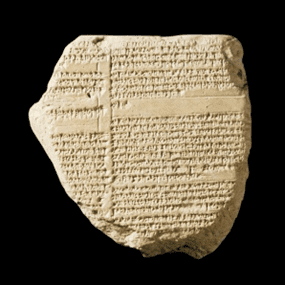 The Chronicle of Nabonassar (Pictured. This tablet is exhibited in the British Museum ANE 92502 (84_2_11,356) gives a very concise statement on the 20th day of the month Tebetu, Sennacherib king of Assyria, his son killed him in a rebellion.[6]
The Chronicle of Nabonassar (Pictured. This tablet is exhibited in the British Museum ANE 92502 (84_2_11,356) gives a very concise statement on the 20th day of the month Tebetu, Sennacherib king of Assyria, his son killed him in a rebellion.[6]
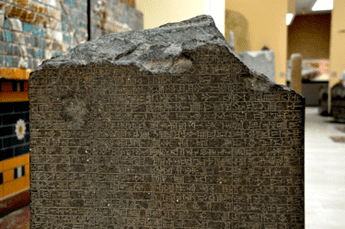 The Istanbul Stele of Nabonidus (Osama Shukir Muhammed Amin, CC BY_NC_SA 3.0) pictured right, is housed in the Istanbul Archaeological Museum. It confirms that Sennacherib was murdered by one or more of his sons but does not name him or them, it only states the assassin was son offspring of his heart.
The Istanbul Stele of Nabonidus (Osama Shukir Muhammed Amin, CC BY_NC_SA 3.0) pictured right, is housed in the Istanbul Archaeological Museum. It confirms that Sennacherib was murdered by one or more of his sons but does not name him or them, it only states the assassin was son offspring of his heart.
Summary
The Bible states that king Sennacherib was struck down by his two sons Adrammelech and Sharezer and that they fled to another land. Archaeology provides a lot of evidence to support this. The Assyrian tablets which are housed in the British Museum comprise a letter concerning Adrammelech conspiracy to murder his father Sennacherib. Note that these tablets confirm the name of Sennacherib’s eldest surviving son Adrammelech in Hebrew, as given in the Bible and they tell of his conspiracy to murder his father.
Three more tablets tell of this event. The Assyrian inscription of Esserhaddon, tell that his father Sennacherib, designated him the be his successor over his elder brothers, hence giving them reason for them to kill him. The inscription goes on to tell of the assassination and that the assassins fled to a far-off land. Again confirming scripture. The Chronicle of Nabonassar gives the date of the assassination as being the 20th day of the month Tebetu and the Istanbul Stele of Nabonidus simply states that Sennacherib’s assassin was the offspring of his heart.
Four completely separate inscriptions confirm what is written in the Bible. Collectively, they give the name of the Assyrian king, his successor, the name of Sennacherib’s assassin(s) and that they escaped retribution by fleeing to another country all confirming the words of the old hymn:
The Bible stands like a rock undaunted ’Mid the raging storms of time; Its pages burn with the truth eternal, And they glow with a light sublime.
References
[1] In ancient times, a city was any town that had a protective wall.[2] 2 Kings 18:33-35.
[3] Daniel David Luckenbill, The Annals of Sennacherib. Chicago: University of Chicago Press. OCLC, 1924.
[4] https://en.wikipedia.org/wiki/Sennacherib
[5] https://www.britishmuseum.org/collection/object/W_1929-1012-1
[6] T C Mitchell, The Bible in the British Museum, The British Museum Press, 2016. Page 73


4 Comments. Leave new
Very good information that is able to be in defence of the Bible well done again Gary
Great work brother
This is very enlightening.
Amazing. Notice how the world believes the archaeological records but questions the Biblical records. In reality the Bible confirms those records also.